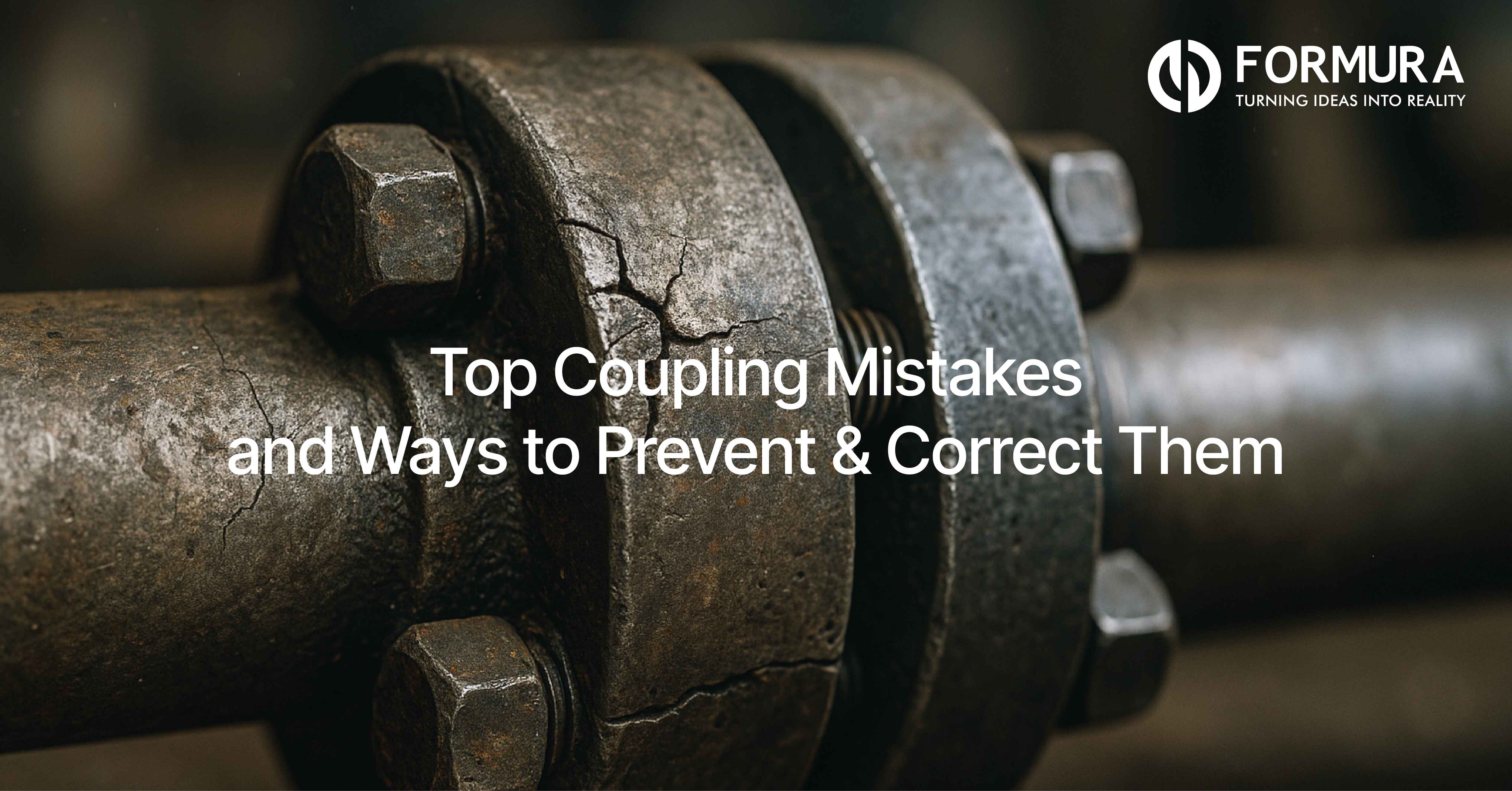Top Coupling Mistakes and Ways to Prevent & Correct Them

In industrial machinery, every component matters. Couplings exemplify this—they join shafts to transmit power, accommodate misalignments, and dampen vibration. Without them, motors and equipment cannot function together.
Yet couplings are often undervalued. Many companies prioritize major equipment and disregard this vital link. The consequences? Expensive failures, downtime, hazards, and unnecessary repairs. Most stem from avoidable errors in coupling selection, installation, or maintenance.
The good news is that these mistakes can be avoided with the right approach. In this article, we’ll explore the most common coupling problems and issues with industrial couplings, along with practical solutions to prevent and correct them.
Understanding Couplings
What is a Coupling?
A coupling is a mechanical device used to connect two shafts at their ends for the purpose of transmitting power. Its primary role is to ensure smooth energy transfer, reduce shock loads, and allow some flexibility in alignment.
Types of Couplings
Different machinery and industries require different types of couplings. Some of the most widely used include:
- Gear Couplings – Heavy-duty couplings designed for high torque and demanding applications.
- Flexible Couplings – Absorb shock loads and accommodate small misalignments.
- Rigid Couplings – Provide precise alignment, best suited where shafts are already in perfect alignment.
- Disc and Grid Couplings – Popular for balancing flexibility with strength in rotating equipment.
(You can explore Formura’s wide range of industrial coupling products for application-specific solutions.)
Applications Across Industries
- Manufacturing: Conveyor belts, mixers, pumps, and assembly systems rely on couplings for continuous power transmission.
- Mining: Crushers, mills, and heavy-duty drills demand strong, reliable couplings that can withstand dust, vibration, and heavy loads.
- Oil & Gas: Pumps and compressors need couplings that perform consistently under extreme pressure and temperature.
- Marine: From ship propulsion to deck machinery, couplings ensure uninterrupted operation in harsh conditions.
- Power Generation: Turbines and generators depend on high-performance couplings to keep plants running 24/7.
Top Coupling Mistakes
1. Incorrect Coupling Selection
One of the biggest common coupling mistakes is selecting the wrong type or size. A mismatch between application requirements (speed, torque, misalignment capacity) and the chosen coupling often leads to premature failure.
2. Poor Alignment
Coupling alignment mistakes are extremely common. Even minor shaft misalignments generate excessive stress, leading to vibration, higher energy consumption, and wear on both the coupling and connected equipment.
3. Ignoring Manufacturer Specifications
Manufacturers provide detailed guidelines for torque, temperature, and alignment. Disregarding these instructions shortens service life and voids warranties.
4. Overlooking Maintenance
Like all machine components, couplings need care. Lack of lubrication (especially in gear couplings) or skipping inspection schedules is one of the main reasons for coupling failure.
5. Improper Installation
Rushing the installation process—such as tightening unevenly, ignoring torque values, or failing to check balance—causes long-term performance issues.
6. Overloading the Coupling
Couplings are designed for specific torque and speed limits. Exceeding these ratings is a surefire way to cause cracks, tooth wear, or a complete breakdown.
7. Using Damaged Components
Reusing worn or cracked parts is another costly mistake. Temporary fixes may save money in the short run, but they increase the risk of catastrophic failure.
Also Read : What Are Industrial Couplings? Types, Uses, and Benefits How to Choose the Right Gear Coupling from a Manufacturer
How to Prevent Coupling Mistakes
- Select wisely: Work with expert industrial coupling suppliers and gear coupling dealers to match the right coupling to your machinery’s exact requirements.
- Ensure precise alignment: Use laser or dial indicators to align shafts accurately.
- Follow specifications: Adhere strictly to torque, speed, and installation guidelines provided by the manufacturer.
- Schedule routine maintenance: Inspect for wear, noise, and vibration regularly. Lubricate gear couplings as recommended.
- Avoid overloading: Ensure machinery operates within the designed load limits.
- Replace damaged parts: Never reuse cracked or worn components—replacement is always safer.
How to Correct Existing Coupling Issues
Even with the best precautions, common coupling issues may arise. Correcting them quickly can prevent further damage.
- Identify early warning signs: Unusual noise, vibration, misalignment, or temperature rise should never be ignored.
- Perform realignment: Loosen the coupling, carefully realign the shafts using precision tools, and secure bolts to the recommended torque.
- Decide between repair or replacement: Minor lubrication issues can be fixed, but heavily worn or cracked couplings must be replaced.
- Partner with experts: Trusted coupling product retailers and gear coupling suppliers can help you troubleshoot problems and provide the right solution.
Benefits of Avoiding Coupling Mistakes
When couplings are correctly selected, installed, and maintained, the benefits are substantial:
- Reduced downtime – Equipment stays in service longer, minimizing costly interruptions.
- Extended machinery life – Protects bearings, shafts, and other connected components.
- Improved efficiency & safety – Smooth operation reduces accidents and energy losses.
- Lower maintenance costs – Preventive measures always cost less than emergency repairs.
Conclusion
Couplings may look small compared to turbines, crushers, or generators, but they are essential for reliable operations. Avoiding common coupling mistakes such as poor alignment, ignoring specifications, or skipping maintenance can make a dramatic difference in performance, safety, and operating costs.
The best approach is proactive—train your maintenance teams, schedule regular inspections, and choose couplings from trusted industrial coupling suppliers, gear coupling manufacturers, and reliable product sellers who can guide you in the selection process.
At Formura, we go beyond being just a coupling product retailer. As one of the trusted gear coupling suppliers and industrial coupling partners, we help you choose, install, and maintain the right solution for your machinery.
Facing a coupling issue or planning a new installation? Talk to our experts today and ensure your equipment runs with efficiency, safety, and reliability—every single day.